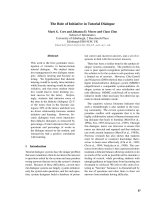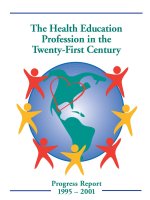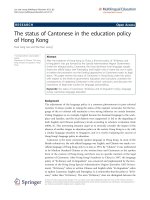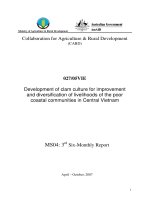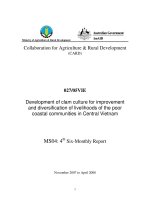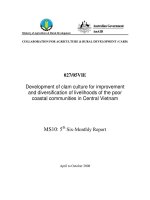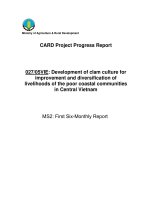The General Education Initiative in Hong Kong-full ms
Bạn đang xem bản rút gọn của tài liệu. Xem và tải ngay bản đầy đủ của tài liệu tại đây (205.78 KB, 26 trang )
The General Education Initiative in Hong Kong:
Organized Contradictions and Emerging Tensions
David Jaffee
Professor of Sociology
University of North Florida
1 UNF Drive
Jacksonville, Florida
32224
904-620-2215
904-620-4415
Keywords:
General Education; Organizational Change; Hong Kong; Asia-Pacific
Do not quote or cite without permission of author.
Abstract:
In 2012 all Hong Kong universities will be extending the length of the undergraduate
degree from three to four years and adding General Education as a degree requirement.
This reform initiative represents a unique case of comprehensive organizational change of
higher education on an unprecedented scale. This paper examines several of the most
significant contradictions and tensions facing this initiative -- the current structure of
higher education based on the British system and the prevailing culture of teaching and
learning in Hong Kong. The nature of these pre-existing conditions, and their
contradictory relationship to the substance and purpose of general and liberal education,
are outlined. The contradictions and tensions generated by the general education initiative
are situated within the larger organizational tension between theory and practice, and
structure and action. The paper delineates some of the strategies developed to address the
existing and emerging tensions.
The General Education Initiative in Hong Kong:
Organized Contradictions and Emerging Tensions
Introduction: The Hong Kong General Education Reform Initiative
In 2005 the University Grants Committee (UGC), the central body governing
higher education in Hong Kong, mandated a change from a three to four year
undergraduate curriculum for the eight universities under its jurisdiction. The additional
year would allow for the development of a General Education (GE) curriculum. The fouryear curriculum would be the required standard for all entering students beginning in Fall
2012. As part of the larger 3-3-4 educational reform, “senior secondary education” would
be reduced to three years and students would be entering institutions of higher education
a year earlier (and younger) in 2012 (see Figure 1).
Based on the various official reports of Hong Kong educational bodies published
beginning in 2000, the formally expressed purpose of the reform was to address
perceived weaknesses in the current curricular structure and system of pedagogy in the
secondary and tertiary sectors. More specifically, it was noted that “learning is still
examination-driven and scant attention is paid to ‘learning to learn’… students are not
given comprehensive learning experiences with little room to think, explore and create.
The pathways for lifelong learning are not as smooth as they should be. To make up for
these weaknesses, we need to uproot outdated ideology and develop a new education
system that is student-focussed”( Hong Kong Education Commission 2000, p.4). The
report recommended that undergraduate education “strike the right balance between the
breadth and the depth of such programmes. This would, in addition to helping students
master the necessary knowledge and skills for specific professions/disciplines, give them
exposure to other learning areas and help them develop a sense of integrity, positive
attitude, a broad vision and important generic skills” (p.9). A later report echoed the same
themes identifying the need for “generic and transferable skills”, to “strike a new balance
between breadth and depth”, and to transcend specialization so that graduates can see
“creative and unexpected connections” (University Grants Committee 2002). In the
higher education sector, a consensus emerged over General Education as the curricular
vehicle to address these issues.
This paper is devoted to a preliminary analysis of this significant and monumental
change to the Hong Kong system of education generally, and higher education sector in
particular. The analysis is based on my direct participation and involvement in the
initiative during the academic year 2010-2011 as a General Education Fulbright scholar
hosted at one of the Hong Kong universities implementing the reform. During that
period, information was gathered from official reports and documents, conversations and
interviews with university administrators and faculty involved in the original decision
and subsequent implementation, and participant observation at meetings in my role as a
Fulbright scholar devoted to assisting Hong Kong universities with the transition.
The present article will focus on two questions pertaining to the Hong Kong
reform within the context of comprehensive organizational change. First, what existing
and institutionalized conditions pose the greatest potential obstacles to the achievement
of reform? Second, what emerging conditions, generic to all forms of organizational
change and particular to the Hong Kong case, generate additional tensions? The basic
assumption underlying the analysis is that organizational change in inevitably fraught
with tensions, contradictions, and unintended consequences (Poole and Van de Ven
1989). These must be recognized and acknowledged in order to understand the
challenges facing implementation, the pace and rhythm of organizational change, and the
obstacles to the successful realization of intended purposes.
Organized Contradictions: Antithetical Curricular Structures and Pedagogical
Cultures
The GE reform in Hong Kong represents a unique case of mandated
transformation of higher education on an unprecedented scale. The process of
organizational change, initiated from within or mandated from without, is a heavily
theorized and studied topic (Demers 2007; Hoag, Ritschard, and Cooper 2002;
Schneider, Brief and Guzzo 1996; Porras and Silvers 1991; Weick and Quinn 1999; Van
de Ven and Poole 1995; Tsoukas and Chia 2002) giving rise to inevitable prescriptions on
how to institute and manage change successfully (Kotter 1996; Mowat 2002; Awbrey
2005; Ratcliff 2004). For the limited purposes of the present article, the introduction and
implementation of a university GE curriculum program will be regarded as a form of
“episodic” (Weick and Quinn1999) and “planned” organizational change (Jian 2007).
The Hong Kong GE initiative can be characterized as strategic, mandated, and formal. It
was officially announced and introduced by a central university system administration,
and has a predetermined implementation date of Fall 2012. Framing the organizational
change in this way does not imply that continuous change dynamics are unimportant or
irrelevant for this case. Rather, the choice of the episodic/planned frame is based on its
ability to highlight immediate pre-existing tensions that must be overcome to move the
initiative forward and the contradictions between theory-practice and structure-action.
If Hong Kong was involved in nothing more than the reform of an existing GE
program, there would be many lessons to learn from the experience of countless US
institutions that have grappled with this notoriously thorny issue (see Awbrey 2005; Irvin
1990; Newton 2000; Gaff 1980; Schneider and Shoenberg 1999). But the Hong Kong
initiative is not a matter of simply revising or modifying an existing GE program, but
rather its inauguration as a new academic program requirement for all students and the
extension of the length of the undergraduate degree an additional year. This represents an
entirely new curricular structure and associated educational philosophy. When considered
in this context, there are two pre-existing structural-cultural barriers that stand out as
potential “organized contradictions” (Rau and Baker 1989) to the successful
implementation of GE. These are the British model of education and the Hong Kong (or
Chinese) culture of teaching and learning.
The British Model
The three year undergraduate program that will be supplanted is a direct legacy of
the British colonial system that has impacted many aspects of Hong Kong institutions and
culture. It is based on a philosophy of education that emphasizes disciplinary
specialization from the moment the student arrives at the university (and even earlier in
the secondary sector). This has impacted the perspective of both administrators and
faculty who have viewed the primary purpose of university education as disciplinary
specialization rather than intellectual broadening. Accompanying this perspective is an
admissions and curricular structure that leaves little latitude for exploration, choice, or
interdisciplinary discovery. While such discipline-centric tendencies certainly exist in the
American academy, it is much more pervasive under a British higher educational system
that has historically had the exclusive task of disciplinary training.
This formal educational structure and the pedagogical philosophical underpinning
stand in sharp contrast with the effort to develop a GE curriculum that emphasizes
“integrative learning”, connections across disciplinary boundaries, and generic skills. For
many or most of the faculty teaching in Hong Kong, there is no direct experience with a
general or liberal education in their roles as faculty or their experience as students; the
concept is entirely alien. I heard several faculty members describe GE as “remedial
education” and something that should be the responsibility of the primary and secondary
sector. Given the educational experience of much of the faculty in Hong Kong, GE is
less legitimate, widely accepted or valued educational undertaking and, therefore, that
much more difficult to develop as an integral component of undergraduate education.
In conversations with several academic administrators, they reported that among
many faculty there was a sentiment that a fourth year devoted to General Education might
be “wasted” and “detract” from the important task of more specialized training. Some
faculty argued that the current three year curriculum was already too crowded, and
insufficiently expansive, to accommodate the necessary disciplinary-based content and
training.
A related factor, cited by one academic administrator, that might further
discourage the acceptance of GE at some of the Hong Kong universities, is the
institutional dominance of the science and engineering faculties and their curricular
values. At several institutions where these colleges and programs exist, there was a
perception that the humanities and social sciences were underappreciated and devalued as
significant disciplines that could contribute positively to student intellectual development.
As a consequence, much of the general education curriculum was viewed as superfluous
or “fluff”. It was in this context that one former administrator suggested “the people
who need to be educated on General Education are not the students but the professors.”
In spite of these institutionalized tendencies, one of the major officially stated
purposes of the 3-3-4 reform is to overcome the narrow specialization and concentration
of the educational system. For this reason, all GE programs at Hong Kong universities
make some reference to the objective of “broadening” or “interdisciplinarity” and GE
course proposals are expected to demonstrate multiple disciplinary perspectives.
The current secondary educational system in Hong Kong, a component of the
larger British system, has also contributed directly to the narrowing and concentration of
student academic subject study (see Leung 2002). Under this system, students proceed
through a “3+2+2” structure that involved two compulsory years (thus, a nine year
compulsory education system) after which students could either exit or continue and
choose an arts or science track (see Figure 1). After two years in that track, students
would take the first of two high stakes exams. Based on the results of that exam, students
would either move out (and pursue alternative forms of post-secondary education) or
move on to the final two years – 6 and 7 -- known as “matriculation”. A final secondary
exam, at the completion of the two years, would determine the prospects for university
entry. Students would sit for exams at both points in the “arts” or in the “sciences”.
Students must choose their intended prioritized major preferences before taking the
university entrance examination. Thus, at a very early point, in comparison to the US,
students are tracked into disciplinary areas (see Suárez-Orozco 2007 for a critical analysis
of this system).
Disciplinary specialization is further reinforced through the university admissions
and student scholarship system. In Hong Kong university scholarships are financed by
the University Grants Committee (UGC). Each institution is allocated a certain number of
financed slots allocated to academic programs. Students apply to (or “bid”) for these
academic program slots. They can apply to up to 25 academic programs and the decision
on which to apply for, and in what priority, is based on anticipated competitiveness. The
success of an application and a bid depends heavily upon the results of high-stakes testing
completed in the final term of the senior year of secondary school. The bottom-line desire
is to avoid being shut out from receiving a financed position in the higher education
system. Therefore, students will apply to programs that they may find less attractive and
desirable, or even for which they have no interest, if it enhances their prospects for
acceptance (some programs have more stringent admission criteria than others).
Under the current system, the students enter the university as a member of an
academic program cohort and follow the prescribed curriculum lockstep as fulltime
students. There is essentially only one path to graduation. Because the state financed
positions are scarce and cover the full tuition, students are discouraged from leaving or
trying to move into another area of study. There is virtually no option for switching
academic majors. The net result is that many students graduate with degrees they do not
want. Institutions hope that students will “want what they get” since they cannot always
“get what they want”.
This system produces two important outcomes. On the positive side, few students
leave and almost all graduate in three years. On the negative side, a significant proportion
of students complete degrees in areas of study they have no interest in or commitment to,
but to which they applied either on the basis of limited knowledge or for the prospects of
being admitted to a university. When asked, many students indicate they would have
chosen, and prefer, a different program of study.
This existing system obviously works against the broad purposes of GE involving
exposure to a wide range of perspectives, integrative and interdisciplinary thinking, and
the cultivation of generic skills untethered to specialized disciplinary content knowledge.
How will things change under the new GE initiative?
In 2012 greater student choice will be introduced. First, students will be selecting
courses that satisfy GE requirements. Second, at some institutions, students will have
some restricted choices over major areas of study. These are significant changes given
that the current system is based largely if not totally on an absence of student choice. But,
again, the changes will be limited and introduced incrementally. There is an
understandable reluctance, coupled with considerable opposition and resistance, to the
most radical policy, routine in most US institutions, of allowing students the choice of
academic major after they arrive at the institution or even after the first year. Instead,
rather than university-wide admission and unrestricted student choice, intermediate and
less draconian measures have been proposed such as, at one institution, admitting
students to a college (e.g. the college of business rather than an academic program) with
the opportunity to select a major at the end of the first year from those offered by the
college.
This concept of student choice can have enormous unintended consequences for
the entire system and it will introduce a great deal of uncertainty in a system that was
characterized by high levels of predictability. Under the current system, predictability is
based on the allocation of funded slots to academic programs. Thus, these programs know
exactly how many students will arrive each Fall -- what courses will be offered, the
enrollment in each course, and faculty staffing requirements -- as students move lockstep
through the prescribed curriculum as a cohort. Under this system, the number of majors is
fixed per cohort. There were very few surprises. The implementation of a GE curriculum,
coupled with a philosophy of greater student choice and the pursuit of student interests,
may well generate new tensions and unwelcome turbulence. More specifically, some
departments will find the number of majors dropping sharply while other departments
may see rising demand beyond the capacity of existing departmental resources. The
remarkable record of all students graduating in the prescribed number of years of the
undergraduate program (three years for the British system) may be blemished as students
change majors and find credits taken in one place don’t apply to another. Graduation rates
may decline. These are all familiar aspects of the US system, but uncommon in the
relatively stable Hong Kong educational environment.
But perhaps the results will be different in Hong Kong. All of these implications
and unintended consequences are based on the assumption that a changing structure will
result in changing behaviors. Will the opportunity to choose result in students shifting
majors after they enter the university? Such structural determinism has to be tempered
with a consideration of cultural constraints on human action. According to people
intimately familiar with Hong Kong culture and higher education, the belief is that
cultural factors will trump structural changes. As one administrator put it: “this is
something that is cultural…Asian students don’t make decisions for personal reasons”.
Another faculty member also suggested that “student interest” will play no role in the
choice of major. More generally, it was argued that the whole concept of “freedom of
choice” was a “Western phenomenon” that did not operate in this arena. Rather, students
are tracked and examined in specific subject areas at an early stage in secondary school,
and parents play the major role in deciding upon the subject areas students will pursue
(attributed to strong tradition of “filial piety” in Chinese culture) (Leung et al. 2011;
Fouad et al. 2008). Once the students reach the universities, according to these observers,
they will follow the track that will provide the highest paying job and/or the quickest
completion of the selected undergraduate degree, largely consonant with parental desires,
regardless of personal interest.
Culture of Learning and Teaching in Hong Kong
The second major condition, potentially antithetical to the principles of liberal
educational practice, is the cultural and behavioral pattern of Asian pedagogy and student
learning. The common claim, some would call it a stereotype or caricature, is that Asian
students excel at rote memorization, resist active forms of teaching and learning, prefer
passive forms of information reception, respond best to teacher-centered pedagogy, and
are unlikely to participate or ask questions in class (Chan 1999; but see Kember 2000;
Kember and Gow 1991; Kennedy 2002 for alternative perspectives and evidence). It is
further claimed that the learning process is structured hierarchically based on deference to
authoritative sources of information and wisdom. In terms of student engagement and
participation, one person put it this way: “In the U.S., the squeaky wheel gets the grease;
in China, the protruding nail gets pounded down.”
Because GE is not just a formal curriculum but also entails a particular
pedagogical philosophy and practice involving discussion, debate, Socratic dialogue, and
critical inquiry (Schneider and Schoenberg 1998), the prevailing philosophy of education
will logically influence the implementation and success of the initiative. The general
education enterprise, in its full liberal and humanistic manifestation, entails particular
modes of instruction and cultivation, and the development of student capacities that
challenge and critically assess the source of all received wisdom (Endres 2009;
Nussbaum 1998). How does such critical thinking and intellectual autonomy fit in the
Asian or Hong Kong context? Will this philosophy find a receptive student and faculty
audience? As Altbach (1998: 50) puts it in his analysis of comparative higher education
and the Western influence “…in adapting primarily Western models of organization,
Asian universities may have also accepted underlying Western values that may not
accurately reflect their own culture and traditions.”
There is a large literature on Asian students generally, and Chinese students in
particular, regarding learning styles and preferences, and teaching and learning practices.
What can this literature tell us about the significance of this “inertial condition” in
potentially thwarting the intended outcomes of the GE reform in Hong Kong?
Jin and Cortazzi (2006) use the concept of a ‘culture of learning’ to describe
“taken-for-granted frameworks of expectations, attitudes, values and beliefs about how to
teach or learn successfully…what teachers and students expect to happen in classrooms
and how participants interpret the format of classroom instruction, the language of
teaching and learning, and how interaction should be accomplished as part of the social
construction of an educational discourse system.”(p.9). In addition to the traits of
Chinese learners described above, this culture, as informed by Confucian philosophy,
involves close careful reading and memorization of authoritative works and material
(“teach the book”) and the passing on of authoritative knowledge through didactic
training. Almost all researchers studying the Chinese learner, even those who take issue
with the stereotypical caricature, accept the idea that students growing up in different
national educational systems can develop differential “cultures of learning”. The research
questions, therefore, usually center on the significance of the cultural differences, what
impact they might have on student learning, and whether they are subject to change.
The literature provides evidence that aspects of the Chinese culture of learning
pose challenges for students in Anglo institutional settings. More specifically, researchers
report Chinese student difficulty: critically assessing texts; expressing personal ideas; using
multiple sources; engaging in spontaneous oral participation; departing from the one-way flow
of communication; engaging in more dialogical and discussion-based learning activities;
replacing a close reading and presentation of the text with occasional detours and
extended examples; working with a diverse set of reading that require analysis,
comparisons, contrasts and synthesis; mounting critiques of established texts or
developing alternative ways to understand the material; outlining the strengths and
weaknesses of authoritative arguments and positions; and grading or evaluating one’s
peers (Jin and Cortazzi 2006; Holmes 2004). Holmes (2004) placed these findings within the
context of a conceptual framework distinguishing learning styles that reflect a
“conserving attitude” with those that reflect an “extending attitude”. In the former,
received knowledge is conserved, memorized, and held sacred; in the latter, existing
knowledge is used as a basis for building and constructing new knowledge.
Zhang and Watkins (2001) examined differences between US and Chinese
students in cognitive development and report that Chinese students’ cognitive
development moved in a more dualistic and less relativistic direction in the domain of
interpersonal relations from the first to the fourth year in college. The authors attribute
this counterintuitive developmental pattern to a lack of choice in the Chinese higher
education system, absence of cognitive dissonance that gives rise to change, and entering
college with predetermined majors that are overspecialized. These explanations, in the
comparative context, have a direct connection to the introduction of a US-style general
education curriculum. As they note (2001; p. 253): “…Chinese students enter college
with predetermined majors that are overspecialized…. In contrast, in the U.S. higher
educational system, students are allowed to choose their major areas of study after they
will have gained sufficient understanding of different academic subjects.”
Zhang and Watkins (2001) also suggest that the way students are assessed will
impact their orientation to learning (see also Sternberg 1997; Biggs 1995; Zhang and
Sternberg 2000). This has direct bearing on their finding that, in contrast to US students,
for Chinese students there was no relationship between the level of cognitive
development and academic achievement. Since the relationship depends upon the types
of assessment teacher’s use, it may be the case that a reliance on memorization and
purely fact-based modes of assessment eliminate the need for relativistic forms of
analysis, thus nullifying the potential positive impact of higher levels of cognitive
development on academic achievement. Overall, in linking the students’ orientation to
systemic and structural institutional factors prevailing in the educational system, they
suggest that, rather than deep-seated cultural traits, the dispositions are subject to change
under conditions of institutional reform.
A similar conclusion is reached by Kennedy (2002 p. 442) “…the evidence
suggests that when the context of learning changes and the modes of teaching and
assessment require adult Hong Kong Chinese learners to adopt new learning styles they
do so provided they are given enough time to adjust.” One of the explicit intended
objectives of the GE reform involves altering the methods of pedagogy and, in turn,
expanding the range of intellectual capacities of Hong Kong students. Evidence for the
malleability of learning dispositions provides a source of hope for the long-term
prospects of the larger reform initiative, but it also places a significant burden on those
who design the “context of learning”.
The GE initiative recognizes the need for alternative modes of pedagogy
alternately described as “engaged”, “active”, or “student-centered”. One of the most
common teaching and learning activities included in GE course proposals reviewed by
this writer was the “group project” and “group presentation”. This typically involved
students working together on a selected topic and presenting the collective product of
their efforts to the larger class. While this introduces more active and collaborative forms
of learning, the widespread use of the strategy suggests it is regarded as a pedagogical
panacea that will singularly address the need for more engaged forms of learning.
In the end, the larger question is whether the apparent contradictions coupling the
British model of academic specialization with an interdisciplinary GE curriculum, and
prevailing patterns of teaching and learning with and GE pedagogy, will be resolved in
favor of new pedagogical and assessment practices. Or, conversely, will the new GE
curriculum simply be absorbed and accommodated within the existing system to which
faculty and students have become accustomed.
Theory and Practice/Structure and Action
Above we have identified two of the most significant, but hardly the only unique,
aspects of Hong Kong higher education that pose challenges to the implementation of a
GE curriculum. We can now place the reform initiative in the larger context of
organizational change generally, and of the higher education variety in particular. It is
important to acknowledge the inherent and inevitable tensions that are generated by such
an institutional transformational regardless of the national and cultural conditions. The
forms of resolution, however, may be shaped by local conditions.
The General Education reform in Hong Kong, like many similar educational
interventions, can be regarded as a form of social engineering. It is based on a theory of
human social, academic, and intellectual development that places a great deal of faith in
the ability of a formal educational curriculum – in this case General Education or Liberal
Studies -- to “produce” qualitatively different students.
The distinction between theory and practice is important to consider for the GE
reform. Theoretically, liberal education should have a transformational impact on
students. But liberal education is manifested and formalized in a general education
curriculum that includes discrete courses that students complete over the course of their
undergraduate education. These courses are often designed to achieve an explicit set of
learning outcomes. More specifically, the intended student learning outcomes of all Hong
Kong universities emphasize, almost exclusively, skills, competencies, and dispositions
over content knowledge. Presented as a rational model of organizational action, the
curricula are the structural means to these developmental ends. But how exactly will the
experience in different GE courses accomplish these outcomes?
The belief that spending time in a series of courses can produce a qualitative
transformation is one of the academy’s universal and central articles of faith. But to what
extent can we expect a GE curriculum to fulfill this lofty expectation? As Schoenberg
(2000) observes for United States institutions, “the great majority of undergraduates
experience the general education program–and sometimes the major as well–as a set of
discrete course requirements to be met rather than as a structure of academic experiences
that together constitute a competent collegiate education as defined by the institution. For
the majority of undergraduate students, the "public curriculum" is a set of requirements
rather than an integrated structure with clear intentions.” Will the Hong Kong experience
be any different?
In this context we are forced to consider the actual pedagogical practices that are
employed in these courses. This is a part of the organizational life of higher education
that is the most difficult to either control or monitor and efforts to micromanage these
activities would likely be met with resistance from faculty and create problems for
administrators.
The potential disconnect between theory and practice strikes at a larger tension
present in all organizations. It has been conceptualized by Schein (1992) as the
divergence between the “espoused” and the “enacted” values of the organization. In this
particular case, universities may espouse fidelity to particular principles of liberal
education and associated pedagogical practices, but these are not necessarily enacted by
the teaching faculty who are charged with the responsibility for to implement and practice
the principles. This organizational problem is regarded as especially pronounced in
higher education. The divergence between “espoused” and “enacted” is closely associated
with the notion of a “loosely coupled” system (Weick 1976) such that the mandated
implementation of a curriculum and associated directives from above do not necessarily
alter the operational day-to-day behavior of organizational members. Universities are
cited as the prototypical case of the loosely-coupled system. For this reason, there
should be concern regarding how the structures of general education are translated into,
or decoupled from, action (Meyer and Rowan 1978). Others have noted similar patterns
where ideas, often embodied in mission statements, change faster than actions, and thus
organizations are routinely guilty of “hypocrisy” (Brunsson 1993).
In the context of Hong Kong educational reforms, Morris and Scott (2003: 71)
refer to this as an “implementation” problem based on the “gap between the intentions of
policy makers and their implementation in the schools.” These forms of “slippage” are
likely to be of particular significance for the kind of institutional changes proposed here
requiring the human enactment of a relatively alien educational and pedagogical
paradigm.
Under such conditions, unintended and undesirable consequences are to be
expected. Jian’s (2007) analysis of unintended consequences rests on the disjunction
between “structure” and “action” that he more precisely conceptualizes as the
relationship between the different social roles within the organization. Higher-level
management is responsible for “change initiation” (creating structures) while the staff or
faculty are charged with the “implementation of change” (action). “Senior management is
responsible for change initiation—to initiate new rules, procedures, and processes;
inscribe them into texts; and announce and “sell” them by various means; employees are
then charged with implementation of change—to translate these texts into social
practices” (p. 13). Given the human vagaries of communication, interpretation, sensemaking, tradition, adaptation, and resistance, the ultimate consequences of planned
organizational change are extremely difficult to predict, anticipate, or control (Balogun
and Johnson 2005; Spillane, Reiser, and Reimer 2002; Moore, 2006; Harris and
Ogbonna 2002).
In order to increase the likelihood that there is some relationship between the
structure of GE and the development of student capacities, or a tighter relationship
between means and ends, many Hong Kong institutions have subscribed to a rationalizing
system of course design known as Outcomes-Based Teaching and Learning (OBTL). In
its pure form, OBTL requires implicit and written articulation of three components of
course design: course intended learning outcomes, assessment tasks, and teaching and
learning activities (Biggs and Tang 2007). All Hong Kong GE programs have developed
some set of “program intended learning outcomes” and each course in the GE program
has course-level intended learning outcomes; the latter are supposed to align with the
former. Further, methods of assessing student achievement, and the teaching and learning
activities, should also align with the outcomes. When faculty propose GE courses they
are required to articulate each of these OBTL components for the proposed course. OBTL
may be one example of “Translating new rules and structures into everyday practice” and
providing a “new discourse that can help construct coherent meaning in their continuous
flow of work experience.” (Jian 2007, p. 25). The extent to which compliance with the
bureaucratic requirements of course proposals, and the inclusion of information and
language of OBTL design, actually translates into a qualitative improvement in the
learning experience of students, again, remains highly uncertain. All of the universities
in Hong Kong have developed GE learning outcomes, GE curricula and associated course
offerings, and a system for reviewing and approving GE course proposals. These are vital
and necessary, but insufficient, conditions for the realization of the reform’s aspirations.
Of all the facets of the OBTL framework, assessment tasks, which determine
student grades, may as critical for the success of the new GE reform as the teaching and
learning activities. There are two aspects of assessment that have posed some challenges
in the course development and design process. The first entails the relationship or
alignment between the learning outcomes and the form of assessment. High levels of
incongruity were noted in course proposals where, for example, an outcome might be that
students will be able to “analyze” some phenomenon but the only assessment strategies
might be multiple-choice examinations and a group project. Thus, there was a
pronounced mismatch between the learning outcomes to be cultivated and the methods
for assessing their realization. The second closely related assessment issue is the heavy
reliance and dependence on the objective multiple choice final examination which is
often assigned greater weight in determining the final grade than other assessments. Hong
Kong has a high-stakes examination culture and it has impacted greatly, as noted above,
the student orientation to learning. But in introducing alternative forms of assessment,
administrators and faculty expressed concern that “examinations” were being eliminated
or undervalued in the new system, replaced by less rigorous grade determinants, and that
this would threaten the academic legitimacy of the enterprise. However, in spite of these
concerns, and as a result of the GE initiative, there is a greater openness to and
incorporation of alternative and more authentic forms of assessment. This seems to be
one of the positive outcomes of the GE reform and one that could contribute to a major
transformation of both faculty and student orientations toward the learning process
consistent with the stated objectives of the reform.
Another positive development along these lines has been the significant expansion
in the faculty development enterprise. Faculty development offices at all Hong Kong
universities have ramped up their programming and staffing to support faculty proposal
development, course design, and pedagogical innovation. One of the primary activities of
this writer, in his capacity as a GE Fulbright in Hong Kong, was to conduct faculty
workshops on how to design and “deliver” GE courses. Many of the GE Fulbright faculty
were housed and worked in faculty development offices at their respective institutions.
The workshop is the standard method for the delivery of faculty development
services. One study, done in the Hong Kong context, suggests that such faculty
development programs can prove efficacious under certain conditions. Ho, Watkins, and
Kelly (2001) employ the dichotomy of the teacher-centered/content-oriented vs. studentcentered/learning-oriented to distinguish faculty and student approaches toward teaching
and learning. They then examine the efficacy of a faculty development program designed
to change these orientations. Using a conceptual change approach, rather than a generic
teaching skills strategy, they study the impact of the program on the changing
conceptions of teaching of the participants, on teaching practices, and on subsequent
student learning. Strategies for conceptual change include self-awareness, confrontation,
exposure to alternative conceptions, and commitment building (Ho, 2000). They report
positive results from this intervention strategy in terms of changed conceptions and, more
importantly, impact on pedagogical practice.
Given the presumed deep-seated philosophical orientation toward didactic forms
of instruction in Hong Kong, faculty development programs that challenge foundational
conceptions and established paradigms of teaching and learning may prove to be the most
efficacious for the purpose of pedagogical change and renewal. Thus we return to the
thorny tension between theory/structure and practice/action. The difficulty to modify and
influence that latter is associated with the prevailing organizational culture. For those
who have attempted to implement change in institutions of higher education, in GE or
elsewhere, the importance of this factor cannot be overstated (see Awbrey 2005; Ratcliff
1997; Tierney 1988; Smircich 1983; Kezar and Eckel 2002). Durable, deep-seated, and
impervious to the fleeting whims of academic administrators, the prevailing academic
culture shapes the value placed on various organizational activities, perceptions of
acceptable forms of knowledge, and professional behaviors. If the established culture is
antithetical to the intended change, and it is not more directly addressed, it is unlikely the
GE reform will have its desired consequences (see Tierney 1999; Wong and Tierney
2001).
The challenge for Hong Kong’s GE reform on this front is no different than in the
United States or elsewhere – motivating faculty participation in pedagogical reflection,
development, and change. When faculty workshop participation is purely voluntary, as is
the most standard practice, it is most likely to attract those already aware, committed, and
sensitive to pedagogical design. This leaves large numbers untouched by faculty
development activities or any critically reflective exercise. Several aspects of the Hong
Kong approach to GE and teaching further complicates this issue. For example, teams of
faculty are involved in teaching a single course but only one of the members of the team
may draft the course proposal or participate in faculty development. Further, where
courses are divided into the lecture and the tutorial, which is quite common in Hong
Kong, and there is a division of labor between professors handling lectures and
instructors the tutorials, curricular coherence may suffer and the intended pedagogical
practices required for successful realization of program outcomes may never be
performed.
However, there may be an even more fundamental challenge. Even if the faculty
members embrace and practice alternative pedagogies associated with liberal education,
will the students suddenly be prepared to engage, interact, debate, participate, discuss,
and criticize? The fear, reluctance, and apprehension students currently exhibit as a
product of their accumulated educational experiences will be difficult to overcome even
under a reform regime that logically extends backward into the secondary curriculum. As
Morris and Scott (2003: 71) have observed for educational reform in Hong Kong, the gap
between intentions and implementation “has been especially pronounced in those reforms
attempting to change the prevailing styles of teaching and learning.” This will obviously
be a slow, incremental, and evolving process.
Conclusion
Hong Kong is currently implementing one of the most comprehensive educational
reforms ever undertaken by a single country. While many national governments have
lamented the quality of their educational system, or the skills of their graduates, few have
been willing to take such a high-risk approach at reorganizing and reconfiguring the
entire secondary and post secondary system. In this sense, Hong Kong is conducting a
grand experiment.
This paper has focused on the post-secondary aspect of the educational reform
involving the additional year of undergraduate education in a General Education
curriculum. The introduction of a General Education curricular structure and a liberal
education pedagogical philosophy challenges two institutionalized features of Hong
Kong education – the British model of education and the Chinese culture of teaching and
learning. Such “organized contradictions” (Rau and Baker 1989) stand as sources of
tension and potential obstacles to the achievement of the intended outcomes of the
reform. The analysis has outlined the substance of these pre-existing conditions of higher
education in Hong Kong and the manner in which they can thwart the larger policy
initiative. The final section of the paper has situated these contradictions within the
broader meta-tension plaguing all organizational change where theory and structure are
unable to sufficiently shape practice and action.
There are many additional challenges and tensions that have not been included in
this analysis (see Finkelstein & Walker 2008; Hanstedt 2010). It is far too early to know
how the contradictions identified here will be resolved. While all eight universities in
Hong Kong have developed a GE curriculum, there are significant variations across
institutions in the specific courses and configuration of distribution requirements, as well
as how the courses will be organized and staffed. Further, success of the initiative may
depend upon the extent to which institutions are able to put in place the requisite
collateral infrastructure. This includes first-year programming, learning communities, and
academic advising to support the needs of the students that will be entering the system in
2012. In a dialectical model of change, where new initiatives interface with existing
antithetical institutional practices and structures, the emerging synthesis is often
unpredictable and unintended. In this case of comprehensive organizational change, it is
likely that the synthesis will be a form of GE with Hong Kong characteristics.
References
Altbach, P. G. (1998). Comparative higher education: Knowledge, the university, and
development Ablex Publishing Corporation.
Awbrey, S. M. (2005). General education reform as organizational change: The
importance of integrating cultural and structural change. The Journal of General
Education, 54(1), 1-21.
Balogun, J., & Johnson, G. (2005). From intended strategies to unintended outcomes: The
impact of change recipient sensemaking. Organization Studies, 26(11), 1573.
Biggs, J. (1995). Assessing for learning: Some dimensions underlying new approaches to
educational assessment. Alberta Journal of Educational Research, 41(1), 1-17.
Biggs, J. B., & Tang, C. (2007). Teaching for quality learning Open university press.
Brunsson, N. (1993). Ideas and actions: Justification and hypocrisy as alternatives to
control. Accounting, Organizations and Society, 18(6), 489-506.
Chan, S. (1999). The Chinese learner–a question of style. Education Training, 41(6/7),
294-305.
Demers, C. (2007). Organizational change theories: A synthesis Sage Publications, Inc.
Endres, B. (2009). Critical pedagogy and liberal education: Reconciling tradition,
critique, and democracy. Philosophy of Education Archive, (0), 59-68.
Finkelstein, M. J. & Walker, E. M. (2008). The progress of Hong Kong’s universities in
implementing the 3-3-4 reforms: A status report on preparations and prospects. Wah
Ching Center for Research on Education in China. Hong Kong-America Center.
Unpublished manuscript.
Fouad, N. A., Kantamneni, N., Smothers, M. K., Chen, Y. L., Fitzpatrick, M., & Terry, S.
(2008). Asian American career development: A qualitative analysis. Journal of
Vocational Behavior, 72(1), 43-59.
Gaff, J. G. (1980). Avoiding the potholes: Strategies for reforming general education.
Educational Record, 61(4), 50–59.
Hanstedt, P. (2010). Hong Kong’s experiment in integrative teaching and learning.
Liberal Education, 96(4).
Harris, L. C., & Ogbonna, E. (2002). The unintended consequences of culture
interventions: A study of unexpected outcomes. British Journal of Management, 13(1),
31-49.
Ho, A. (2000). ‘A conceptual change approach to staff development: a model for
programme design’, International Journal of Academic Development 5(1), 30–41.
Ho, A., Watkins, D., & Kelly, M. (2001). The conceptual change approach to improving
teaching and learning: An evaluation of a Hong Kong staff development programme.
Higher Education, 42(2), 143-169.
Hoag, B. G., Ritschard, H. V., & Cooper, C. L. (2002). Obstacles to effective
organizational change: The underlying reasons. Leadership & Organization
Development Journal, 23(1), 6-15.
Holmes, P. (2004). Negotiating differences in learning and intercultural communication.
Business Communication Quarterly, 67(3), 294.
Hong Kong Education Commission. (2000). Learning for life, learning through life:
Reform proposals for the education system in Hong Kong. Accessed July 5, 2011.
Irvin, G. (1990). The plight of general education. Educational Forum, , 54(4) 371-387.
Jian, G. (2007). Unpacking unintended consequences in planned organizational change: A
process model. Management Communication Quarterly, 21(1), 5.
Jin, L., & Cortazzi, M. (2006). Changing practices in Chinese cultures of learning.
Language Culture and Curriculum, 19(1), 5.
Kember, D. (2000). Misconceptions about the learning approaches, motivation and study
practices of Asian students. Higher Education, 40(1), 99-121.
Kember, D., & Gow, L. (1991). A challenge to the anecdotal stereotype of the asian
student. Studies in Higher Education, 16(2), 117-128.
Kennedy, P. (2002). Learning cultures and learning styles: myth-understandings about
adult (Hong Kong) Chinese learners. International Journal of Lifelong Education, 21(5),
430-445.
Kezar, A. J., & Eckel, P. D. (2002). The effect of institutional culture on change strategies
in higher education: Universal principles or culturally responsive concepts? The
Journal of Higher Education, 73(4), 435-460.
Kotter, J. P. (1996). Leading change. Harvard Business School Press.
Leung, S.A., Hou, Z-H., Gati, I., Li, X. (2011). Effects of parental expectations and
cultural-values orientation on career decision-making difficulties of Chinese University
students. Journal of Vocational Behavior 78, 11–20
Leung, S. A. (2002). Career counseling in hong kong: Meeting the social challenges.
Career Development Quarterly, 50(3), 237-245.
Meyer, J. W., & Rowan, B. (2001). The structure of educational organizations. Schools
and Society: A Sociological Approach to Education, , 77-87.
Moore, A. (2006). Recognising desire: A psychosocial approach to understanding
education policy implementation and effect. Oxford Review of Education, 32(4), 487–
503.
Morris, P., & Scott, I. (2003). Education reform and policy implementation in Hong
Kong. Journal of Education Policy, 18 (1), 71-84.
Mowat, J. (2002). Managing organizational change.
Newton, R. R. (2000). Tensions and models in general education planning. The Journal
of General Education, 49(3), 165-181.
Nussbaum, M. C. (1998). Cultivating humanity: A classical defense of reform in liberal
education Harvard Univ Press.
Poole, M. S., & van de Ven, A. H. (1989). Using paradox to build management and
organization theories. Academy of Management Review, 14(4), 562-578.
Porras, J. I., & Silvers, R. C. (1991). Organization development and transformation.
Annual Review of Psychology, 42(1), 51-78.
Ratcliff, J. L. (2004). Re‐envisioning the change process in general education. New
Directions for Higher Education, 2004(125), 97-118.
Rau, W., & Baker, P. J. (1989). The organized contradictions of academe: Barriers facing
the next academic revolution. Teaching Sociology, 17(2), 161-175.
Schein, E. H. (1992). Organizational culture and leadership Jossey-Bass.
Schneider, B., Brief, A. P., & Guzzo, R. A. (1996). Creating a climate and culture for
sustainable organizational change. Organizational Dynamics, 24(4), 7-19.
Schneider, C. G., & Shoenberg, R. (1998). Contemporary understandings of liberal
education: The academy in transition. Association of American Colleges and
Universities.
Schneider, C. G., & Shoenberg, R. (1999). Habits hard to break: How persistent features
of campus life frustrate curricular reform. Change: The Magazine of Higher
Learning, 31(2), 30-35.
Shoenberg, R. (2000). The "Public curriculum" of Colleges and Universities and the
Experience of Students. Briefing Papers. Association of American Colleges and
Universities. />Smircich, L. (1983). Concepts of culture and organizational analysis. Administrative
Science Quarterly, 28(3), 339-358.
Spillane, J. P., Reiser, B. J., & Reimer, T. (2002). Policy implementation and cognition:
Reframing and refocusing implementation research. Review of Educational
Research, 72(3), 387.
Sternberg, R. J. (1997). Intelligence and lifelong learning: What's new and how can we
use it?* 1. American Psychologist, 52(10), 1134-1139.
Suárez-Orozco, M. M. (2007). Learning in the global era: International perspectives on
globalization and education Univ of California Press.
Tierney, W. G. (1988). Organizational culture in higher education: defining the essentials.
The Journal of Higher Education, 59(1), 2-21.
Tsoukas, H., & Chia, R. (2002). On organizational becoming: Rethinking organizational
change. Organization Science, 567-582.
University Grants Committee. (2002). Higher education in Hong Kong: Report of the
University Grants Committee. Hong Kong.
Accessed July 5,
2011.
Van de Ven, A. H., & Poole, M. S. (1995). Explaining development and change in
organizations. The Academy of Management Review, 20(3), 510-540.
Weick, K. E. (1976). Educational organizations as loosely coupled systems.
Administrative Science Quarterly, 21(1), 1-19.
Weick, K. E., & Quinn, R. E. (1999). Organizational change and development. Annual
Review of Psychology, 50(1), 361-386.
Wong, M. P. A., & Tierney, W. G. (2001). Reforming faculty work: Culture, structure, and
the dilemma of organizational change. Teachers College Record, 103(6), 1081-1101.
Zhang, L. F., & Sternberg, R. J. (2000). Are learning approaches and thinking styles
related? A study in two Chinese populations. The Journal of Psychology:
Interdisciplinary and Applied, 134(5), 469-489.
Zhang, L. F., & Watkins, D. (2001). Cognitive development and student approaches to
learning: An investigation of Perry’s theory with Chinese and US university students.
Higher Education, 41(3), 239-261.

